"Electronic coupling and hence hybridization of atoms serves as the bas is for the rich properties for the endless library of naturally occurring molecules. Colloidal quantum dots (CQDs) manifesting quantum strong confinement possess atomic-like characteristics with s and p electronic levels, which popularized the notion of CQDs as artificial atoms. Continuing this analogy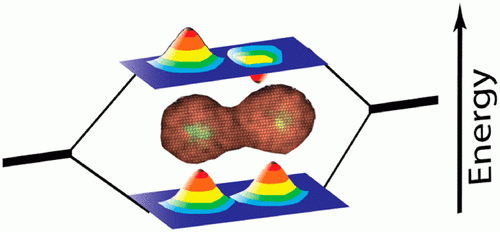 , when two atoms are close enough to form a molecule so that their orbitals start overlapping, the orbitals energies start to split into bonding and antibonding states made out of hybridized orbitals. The same concept is also applicable for two fused core–shell nanocrystals in close proximity. Their band edge states, which dictate the emitted photon energy, start to hybridize, changing their electronic and optical properties. Thus, an exciting direction of “artificial molecules” emerges, leading to a multitude of possibilities for creating a library of new hybrid nanostructures with novel optoelectronic properties with relevance toward diverse applications including quantum technologies. , when two atoms are close enough to form a molecule so that their orbitals start overlapping, the orbitals energies start to split into bonding and antibonding states made out of hybridized orbitals. The same concept is also applicable for two fused core–shell nanocrystals in close proximity. Their band edge states, which dictate the emitted photon energy, start to hybridize, changing their electronic and optical properties. Thus, an exciting direction of “artificial molecules” emerges, leading to a multitude of possibilities for creating a library of new hybrid nanostructures with novel optoelectronic properties with relevance toward diverse applications including quantum technologies. The controlled separation and the barrier height between two adjacent quantum dots are key variables for dictating the magnitude of the coupling energy of the confined wave functions. In the past, coupled double quantum dot architectures prepared by molecular beam epitaxy revealed a coupling energy of few millielectron volts, which limits the applications to mostly cryogenic operation. The realization of artificial quantum molecules with sufficient coupling energy detectable at room temperature calls for the use of colloidal semiconductor nanocrystal building blocks. Moreover, the tunable surface chemistry widely opens the predesigned attachment strategies as well as the solution processing ability of the prepared artificial molecules, making the colloidal nanocrystals as an ideal candidate for this purpose. Despite several approaches that demonstrated enabling of the coupled structures, a general and reproducible method applicable to a broad range of colloidal quantum materials is needed for systematic tailoring of the coupling strength based on a dictated barrier. This Account addresses the development of nanocrystal chemistry to create coupled colloidal quantum dot molecules and to study the controlled electronic coupling and their emergent properties. The simplest nanocrystal molecule, a homodimer formed from two core/shell nanocrystal monomers, in analogy to homonuclear diatomic molecules, serves as a model system. The shell material of the two CQDs is structurally fused, resulting in a continuous crystal. This lowers the potential energy barrier, enabling the hybridization of the electronic wave functions. The direct manifestation of the hybridization reflects on the band edge transition shifting toward lower energy and is clearly resolved at room temperature. The hybridization energy within the single homodimer molecule is strongly correlated with the extent of structural continuity, the delocalization of the exciton wave function, and the barrier thickness as calculated numerically. The hybridization impacts the emitted photon statistics manifesting faster radiative decay rate, photon bunching effect, and modified Auger recombination pathway compared to the monomer artificial atoms. Future perspectives for the nanocrystals chemistry paradigm are also highlighted." |
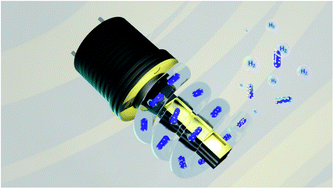


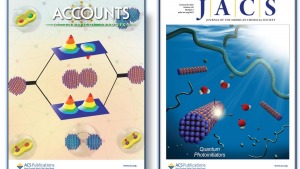
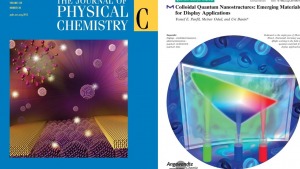
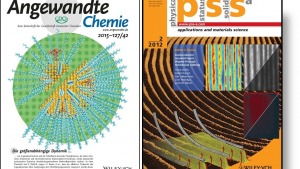

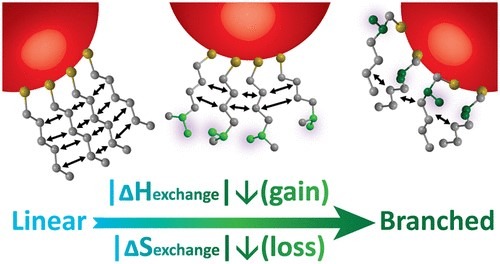 Attention is usually paid to the ligand binding group, while the impact of the ligand chain backbone structure is less discussed. Using isothermal titration calorimetry (ITC), we studied the effect of structural changes in the ligand chain on the thermodynamics of the exchange reaction for oleate coated CdSe NCs, comparing linear and branched alkylthiols. The investigated alkylthiol ligands differed in their backbone length, branching position, and branching group length. Compared to linear ligands, lower exothermicity and entropy loss were observed for an exchange with branched ligands, due to steric hindrance in ligand packing, thereby justifying their previous classification as “entropic ligands”. Mean-field calculations for ligand binding demonstrate the contribution to the overall entropy originating from ligand conformational entropy, which is diminished upon binding mainly by packing of NC-bound ligands. Model calculations and the experimental ITC data both point to an interplay between the branching position and the backbone length in determining the entropic nature of the branched ligand. Our findings suggest that the most entropic ligand should be a short, branched ligand with short branching group located toward the middle of the ligand chain. The insights provided by this work also contribute to a future smarter NC surface design, which is an essential tool for their implementation in diverse applications.
Attention is usually paid to the ligand binding group, while the impact of the ligand chain backbone structure is less discussed. Using isothermal titration calorimetry (ITC), we studied the effect of structural changes in the ligand chain on the thermodynamics of the exchange reaction for oleate coated CdSe NCs, comparing linear and branched alkylthiols. The investigated alkylthiol ligands differed in their backbone length, branching position, and branching group length. Compared to linear ligands, lower exothermicity and entropy loss were observed for an exchange with branched ligands, due to steric hindrance in ligand packing, thereby justifying their previous classification as “entropic ligands”. Mean-field calculations for ligand binding demonstrate the contribution to the overall entropy originating from ligand conformational entropy, which is diminished upon binding mainly by packing of NC-bound ligands. Model calculations and the experimental ITC data both point to an interplay between the branching position and the backbone length in determining the entropic nature of the branched ligand. Our findings suggest that the most entropic ligand should be a short, branched ligand with short branching group located toward the middle of the ligand chain. The insights provided by this work also contribute to a future smarter NC surface design, which is an essential tool for their implementation in diverse applications. on one hand, a ‘‘connected-but-confined’’ situation where neighboring CQDs are weakly fused to each other, manifesting a weak-coupling regime, and on the other hand, a ‘‘connected-anddelocalized’’ situation where the neck is filled beyond the facet size, leading to a rod-like architecture manifesting strong coupling. The interplay between the radiative and non-radiative Auger decays of these states turns emitted photons from the CQDMs in the weakcoupling regime highly bunched unlike CQD monomers, while the antibunching is regained at the strong-coupling regime. This work sets an analogy for the artificial molecule CQDMs with regular molecules, where the two distinct regimes of weak and strong coupling correspond to ionic- or covalent-type bonding, respectively.
on one hand, a ‘‘connected-but-confined’’ situation where neighboring CQDs are weakly fused to each other, manifesting a weak-coupling regime, and on the other hand, a ‘‘connected-anddelocalized’’ situation where the neck is filled beyond the facet size, leading to a rod-like architecture manifesting strong coupling. The interplay between the radiative and non-radiative Auger decays of these states turns emitted photons from the CQDMs in the weakcoupling regime highly bunched unlike CQD monomers, while the antibunching is regained at the strong-coupling regime. This work sets an analogy for the artificial molecule CQDMs with regular molecules, where the two distinct regimes of weak and strong coupling correspond to ionic- or covalent-type bonding, respectively.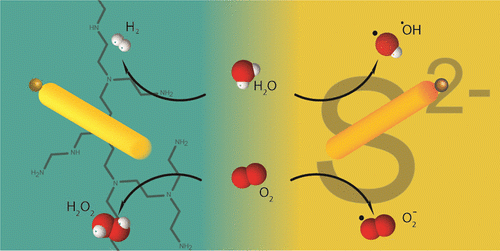 Upon sulfide coating, one-electron processes – namely the oxidative production of hydroxyl radicals and the reductive production of superoxide – were increased, whereas the activity for two-electron reduction processes – H2 and hydrogen peroxide generation – was hampered. These findings indicate a double-edged sword effect for sulfide coating that on one side relieves the hole extraction bottleneck from the semiconductor segment and, on the other hand, poisons the metal domain restricting its reductive capacity for the two-electron processes requiring a chemisorption step on the metal surface. The work further demonstrates the importance of surface properties for the photocatalytic action of such hybrid nanoparticle systems.
Upon sulfide coating, one-electron processes – namely the oxidative production of hydroxyl radicals and the reductive production of superoxide – were increased, whereas the activity for two-electron reduction processes – H2 and hydrogen peroxide generation – was hampered. These findings indicate a double-edged sword effect for sulfide coating that on one side relieves the hole extraction bottleneck from the semiconductor segment and, on the other hand, poisons the metal domain restricting its reductive capacity for the two-electron processes requiring a chemisorption step on the metal surface. The work further demonstrates the importance of surface properties for the photocatalytic action of such hybrid nanoparticle systems.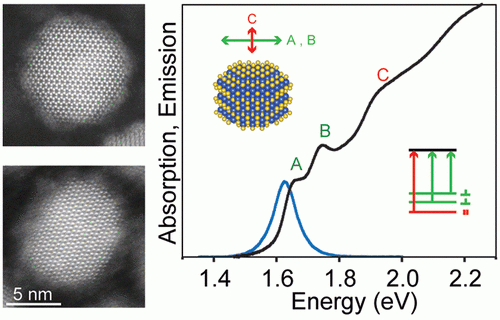 The attained InP nanocrystals manifest a highly resolved absorption spectrum with a narrow emission line of 80 meV, and photoluminescence quantum yield of up to 40%. Optical anisotropy measurements on ensemble and single particle bases show the occurrence of polarized transitions directly mirroring the anisotropic wurtzite lattice, as also manifested from modeling of the quantum confined electronic levels. This shows a green synthesis path for achieving wurtzite InP nanocrystals with desired optoelectronic properties including color purity and light polarization with potential for diverse optoelectronic applications.Indium phosphide (InP) nanocrystals are emerging as an alternative to heavy metal containing nanocrystals for optoelectronic applications but lag behind in terms of synthetic control. Herein, luminescent wurtzite InP nanocrystals with narrow size distribution were synthesized via a cation exchange reaction from hexagonal Cu3P nanocrystals. A comprehensive surface treatment with NOBF4 was performed, which removes excess copper while generating stoichiometric In/P nanocrystals with fluoride surface passivation. The attained InP nanocrystals manifest a highly resolved absorption spectrum with a narrow emission line of 80 meV, and photoluminescence quantum yield of up to 40%. Optical anisotropy measurements on ensemble and single particle bases show the occurrence of polarized transitions directly mirroring the anisotropic wurtzite lattice, as also manifested from modeling of the quantum confined electronic levels. This shows a green synthesis path for achieving wurtzite InP nanocrystals with desired optoelectronic properties including color purity and light polarization with potential for diverse optoelectronic applications.
The attained InP nanocrystals manifest a highly resolved absorption spectrum with a narrow emission line of 80 meV, and photoluminescence quantum yield of up to 40%. Optical anisotropy measurements on ensemble and single particle bases show the occurrence of polarized transitions directly mirroring the anisotropic wurtzite lattice, as also manifested from modeling of the quantum confined electronic levels. This shows a green synthesis path for achieving wurtzite InP nanocrystals with desired optoelectronic properties including color purity and light polarization with potential for diverse optoelectronic applications.Indium phosphide (InP) nanocrystals are emerging as an alternative to heavy metal containing nanocrystals for optoelectronic applications but lag behind in terms of synthetic control. Herein, luminescent wurtzite InP nanocrystals with narrow size distribution were synthesized via a cation exchange reaction from hexagonal Cu3P nanocrystals. A comprehensive surface treatment with NOBF4 was performed, which removes excess copper while generating stoichiometric In/P nanocrystals with fluoride surface passivation. The attained InP nanocrystals manifest a highly resolved absorption spectrum with a narrow emission line of 80 meV, and photoluminescence quantum yield of up to 40%. Optical anisotropy measurements on ensemble and single particle bases show the occurrence of polarized transitions directly mirroring the anisotropic wurtzite lattice, as also manifested from modeling of the quantum confined electronic levels. This shows a green synthesis path for achieving wurtzite InP nanocrystals with desired optoelectronic properties including color purity and light polarization with potential for diverse optoelectronic applications.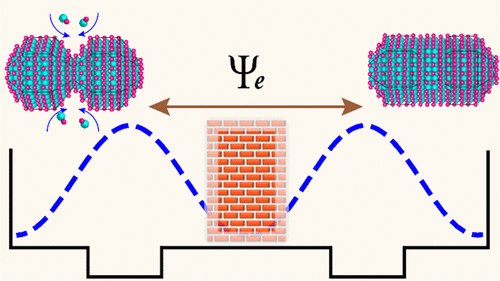 Herein we introduce a colloidal approach to control the neck formation at the interface between the two CQDs in such artificial molecular constructs. This allows the tailoring of the neck barrier in prelinked homodimers formed via fusion of multifaceted wurtzite CdSe/CdS CQDs. The effects of reaction time, temperature, and excess ligands are studied. The neck filling process follows an intraparticle ripening mechanism at relatively mild reaction conditions while avoiding interparticle ripening. The degree of surface ligand passivation plays a key role in activating the surface atom diffusion to the neck region. The degree of neck filling strongly depends also on the initial relative orientation of the two CQDs, where homonymous plane attachment allows for facile neck growth, unlike the case of heteronymous plane attachment. Upon neck filling, the observed red-shift of the absorption and fluorescence measured both for ensemble and single dimers is assigned to enhanced hybridization of the confined wave function in CQD dimer molecules, as supported by quantum calculations. The fine-tuning of the particle interface introduced herein provides therefore a powerful tool to further control the extent of hybridization and coupling in CQD molecules.Coupled colloidal quantum dot (CQD) dimers represent a new class of artificial molecules composed of fused core/shell semiconductor nanocrystals. The electronic coupling and wave function hybridization are enabled by the formation of an epitaxial connection with a coherent lattice between the shells of the two neighboring quantum dots where the shell material and its dimensions dictate the quantum barrier characteristics for the charge carriers. Herein we introduce a colloidal approach to control the neck formation at the interface between the two CQDs in such artificial molecular constructs. This allows the tailoring of the neck barrier in prelinked homodimers formed via fusion of multifaceted wurtzite CdSe/CdS CQDs. The effects of reaction time, temperature, and excess ligands are studied. The neck filling process follows an intraparticle ripening mechanism at relatively mild reaction conditions while avoiding interparticle ripening. The degree of surface ligand passivation plays a key role in activating the surface atom diffusion to the neck region. The degree of neck filling strongly depends also on the initial relative orientation of the two CQDs, where homonymous plane attachment allows for facile neck growth, unlike the case of heteronymous plane attachment. Upon neck filling, the observed red-shift of the absorption and fluorescence measured both for ensemble and single dimers is assigned to enhanced hybridization of the confined wave function in CQD dimer molecules, as supported by quantum calculations. The fine-tuning of the particle interface introduced herein provides therefore a powerful tool to further control the extent of hybridization and coupling in CQD molecules.
Herein we introduce a colloidal approach to control the neck formation at the interface between the two CQDs in such artificial molecular constructs. This allows the tailoring of the neck barrier in prelinked homodimers formed via fusion of multifaceted wurtzite CdSe/CdS CQDs. The effects of reaction time, temperature, and excess ligands are studied. The neck filling process follows an intraparticle ripening mechanism at relatively mild reaction conditions while avoiding interparticle ripening. The degree of surface ligand passivation plays a key role in activating the surface atom diffusion to the neck region. The degree of neck filling strongly depends also on the initial relative orientation of the two CQDs, where homonymous plane attachment allows for facile neck growth, unlike the case of heteronymous plane attachment. Upon neck filling, the observed red-shift of the absorption and fluorescence measured both for ensemble and single dimers is assigned to enhanced hybridization of the confined wave function in CQD dimer molecules, as supported by quantum calculations. The fine-tuning of the particle interface introduced herein provides therefore a powerful tool to further control the extent of hybridization and coupling in CQD molecules.Coupled colloidal quantum dot (CQD) dimers represent a new class of artificial molecules composed of fused core/shell semiconductor nanocrystals. The electronic coupling and wave function hybridization are enabled by the formation of an epitaxial connection with a coherent lattice between the shells of the two neighboring quantum dots where the shell material and its dimensions dictate the quantum barrier characteristics for the charge carriers. Herein we introduce a colloidal approach to control the neck formation at the interface between the two CQDs in such artificial molecular constructs. This allows the tailoring of the neck barrier in prelinked homodimers formed via fusion of multifaceted wurtzite CdSe/CdS CQDs. The effects of reaction time, temperature, and excess ligands are studied. The neck filling process follows an intraparticle ripening mechanism at relatively mild reaction conditions while avoiding interparticle ripening. The degree of surface ligand passivation plays a key role in activating the surface atom diffusion to the neck region. The degree of neck filling strongly depends also on the initial relative orientation of the two CQDs, where homonymous plane attachment allows for facile neck growth, unlike the case of heteronymous plane attachment. Upon neck filling, the observed red-shift of the absorption and fluorescence measured both for ensemble and single dimers is assigned to enhanced hybridization of the confined wave function in CQD dimer molecules, as supported by quantum calculations. The fine-tuning of the particle interface introduced herein provides therefore a powerful tool to further control the extent of hybridization and coupling in CQD molecules.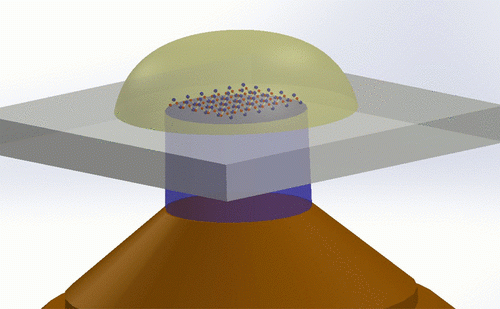 Nitrogen-vacancy (NV) color centers in diamond have been demonstrated as useful magnetic sensors, in particular for measuring spin fluctuations and achieving high sensitivity and spatial resolution. These abilities can be used to explore various biological and chemical processes, catalyzed by reactive oxygen species (ROS). Here we demonstrate a novel approach to measure and quantify hydroxyl radicals with high spatial resolution, using the fluorescence difference between NV charged states. According to the results, the achieved NV sensitivity is
Nitrogen-vacancy (NV) color centers in diamond have been demonstrated as useful magnetic sensors, in particular for measuring spin fluctuations and achieving high sensitivity and spatial resolution. These abilities can be used to explore various biological and chemical processes, catalyzed by reactive oxygen species (ROS). Here we demonstrate a novel approach to measure and quantify hydroxyl radicals with high spatial resolution, using the fluorescence difference between NV charged states. According to the results, the achieved NV sensitivity is  , realized in situ without spin labels and localized to a volume of ∼10 picoliters.
, realized in situ without spin labels and localized to a volume of ∼10 picoliters.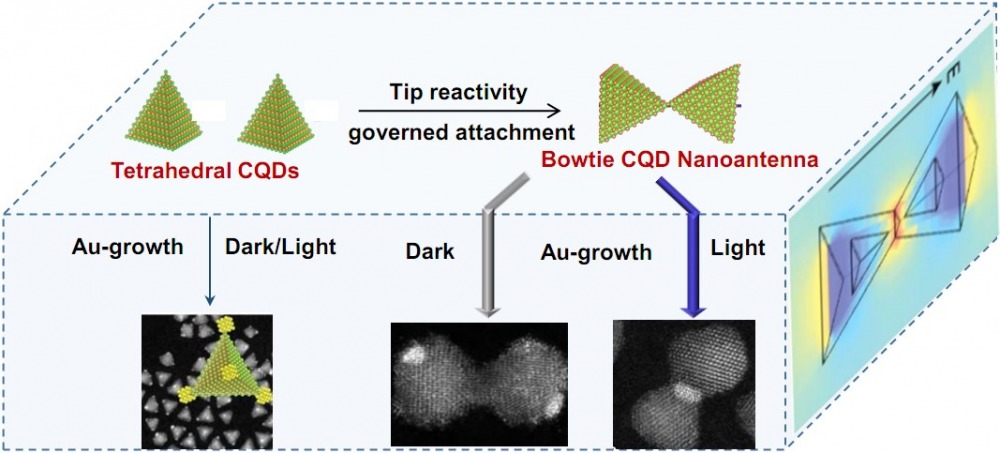 Top-down fabricated nanoantenna architectures of both metallic and dielectric materials show powerful functionalities for Raman and fluorescence enhancement with relevance to single molecule sensing while inducing directionality of chromophore emission with implications for single photon sources. We synthesize the smallest bow-tie nanoantenna by selective tip-to-tip fusion of two tetrahedral colloidal quantum dots (CQDs) forming a dimer. While the tetrahedral monomers emit non-polarized light, the bow-tie architecture manifests nanoantenna functionality of enhanced emission polarization along the bow-tie axis, as predicted theoretically and revealed by single-particle spectroscopy. Theory also predicts the formation of an electric-field hotspot at the bow-tie epicenter. This is utilized for selective light-induced photocatalytic metal growth at that location, unlike growth on the free tips in dark conditions, thus demonstrating bow-tie dimer functionality as a photochemical reaction center.
Top-down fabricated nanoantenna architectures of both metallic and dielectric materials show powerful functionalities for Raman and fluorescence enhancement with relevance to single molecule sensing while inducing directionality of chromophore emission with implications for single photon sources. We synthesize the smallest bow-tie nanoantenna by selective tip-to-tip fusion of two tetrahedral colloidal quantum dots (CQDs) forming a dimer. While the tetrahedral monomers emit non-polarized light, the bow-tie architecture manifests nanoantenna functionality of enhanced emission polarization along the bow-tie axis, as predicted theoretically and revealed by single-particle spectroscopy. Theory also predicts the formation of an electric-field hotspot at the bow-tie epicenter. This is utilized for selective light-induced photocatalytic metal growth at that location, unlike growth on the free tips in dark conditions, thus demonstrating bow-tie dimer functionality as a photochemical reaction center. , when two atoms are close enough to form a molecule so that their orbitals start overlapping, the orbitals energies start to split into bonding and antibonding states made out of hybridized orbitals. The same concept is also applicable for two fused core–shell nanocrystals in close proximity. Their band edge states, which dictate the emitted photon energy, start to hybridize, changing their electronic and optical properties. Thus, an exciting direction of “artificial molecules” emerges, leading to a multitude of possibilities for creating a library of new hybrid nanostructures with novel optoelectronic properties with relevance toward diverse applications including quantum technologies.
, when two atoms are close enough to form a molecule so that their orbitals start overlapping, the orbitals energies start to split into bonding and antibonding states made out of hybridized orbitals. The same concept is also applicable for two fused core–shell nanocrystals in close proximity. Their band edge states, which dictate the emitted photon energy, start to hybridize, changing their electronic and optical properties. Thus, an exciting direction of “artificial molecules” emerges, leading to a multitude of possibilities for creating a library of new hybrid nanostructures with novel optoelectronic properties with relevance toward diverse applications including quantum technologies.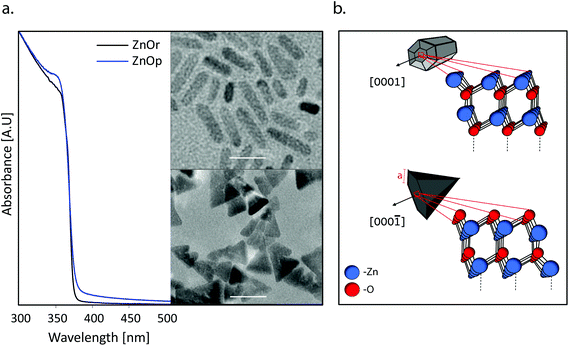 Semiconductor nanocrystal based photoinitiators, quantum PIs, are a viable alternative to organic photoinitiators demonstrating unique advantages, including a broad and tunable excitation window, limited migration, and more. Aiming towards efficient quantum PIs with tunable properties, a deeper understanding of the relationships between the nanoparticle properties and their efficiency is required. Herein, we studied the morphological effect on ZnO nanocrystals functioning as photoinitiators in both water-based and solvent-free formulations by comparing rod and pyramidal shaped particles of similar volumes and nearly identical surface area. Superior polymerization performances are measured for the nanorods. Photocatalytic characterization including oxygen consumption and reactive oxygen species formation as well as dyes reduction and oxidation, also showed enhanced activities for the nanorods. The different performances were attributed to the anisotropic nanorod morphology which is beneficial for charge separation as well as to the presence of a reactive [0001] facet in the nanorods, which is known to increase the adsorption of molecular oxygen and anionic molecules, thus affecting the catalytic activity. These observations, along with the higher photoinitiation efficiency of the ZnO nanorods, bring them closer to functionality as photoinitiators in numerous photopolymerization applications.
Semiconductor nanocrystal based photoinitiators, quantum PIs, are a viable alternative to organic photoinitiators demonstrating unique advantages, including a broad and tunable excitation window, limited migration, and more. Aiming towards efficient quantum PIs with tunable properties, a deeper understanding of the relationships between the nanoparticle properties and their efficiency is required. Herein, we studied the morphological effect on ZnO nanocrystals functioning as photoinitiators in both water-based and solvent-free formulations by comparing rod and pyramidal shaped particles of similar volumes and nearly identical surface area. Superior polymerization performances are measured for the nanorods. Photocatalytic characterization including oxygen consumption and reactive oxygen species formation as well as dyes reduction and oxidation, also showed enhanced activities for the nanorods. The different performances were attributed to the anisotropic nanorod morphology which is beneficial for charge separation as well as to the presence of a reactive [0001] facet in the nanorods, which is known to increase the adsorption of molecular oxygen and anionic molecules, thus affecting the catalytic activity. These observations, along with the higher photoinitiation efficiency of the ZnO nanorods, bring them closer to functionality as photoinitiators in numerous photopolymerization applications.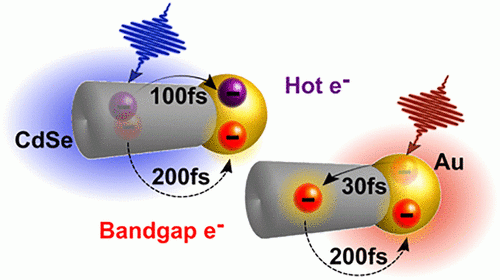

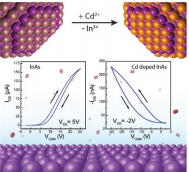
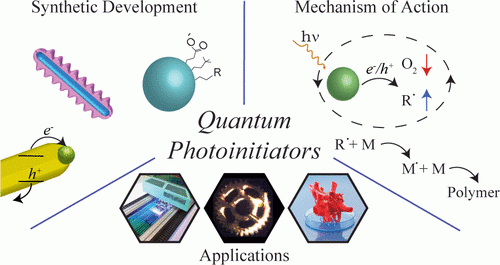 "Semiconductor Nanocrystals are Promising Photocatalysts for a wide range of applications, ranging from alternative fuel generation to biomedical and environmental applications. This stems from their diverse properties, including flexible spectral tunability, stability, and photocatalytic efficiencies. Their functionality depends on the complex influence of multiple parameters, including their composition, dimensions, architecture, surface coating, and environmental conditions. A particularly promising direction for rapid adoption of these nanoparticles as photocatalysts is their ability to act as photoinitiators (PIs) for radical polymerization. Previous studies served to demonstrate the proof of concept for the use of quantum confined semiconductor nanocrystals as photoinitiators, coining the term Quantum PIs, and provided insights for their photocatalytic mechanism of action. However, these early reports suffered from low efficiencies while requiring purging with inert gases, use of additives, and irradiation by high light intensities with very long excitation durations, which limited their potential for real-life applications. The progress in nanocrystal syntheses and surface engineering has opened the way to the introduction of the next generation of Quantum PIs. Herein, we introduce the research area of nanocrystal photocatalysts, review their studies as Quantum PIs for radical polymerization, from suspension polymerization to novel printing, as well as in a new family of polymerization techniques, of reversible deactivation radical polymerization, and provide a forward-looking view for the challenges and prospects of this field."
"Semiconductor Nanocrystals are Promising Photocatalysts for a wide range of applications, ranging from alternative fuel generation to biomedical and environmental applications. This stems from their diverse properties, including flexible spectral tunability, stability, and photocatalytic efficiencies. Their functionality depends on the complex influence of multiple parameters, including their composition, dimensions, architecture, surface coating, and environmental conditions. A particularly promising direction for rapid adoption of these nanoparticles as photocatalysts is their ability to act as photoinitiators (PIs) for radical polymerization. Previous studies served to demonstrate the proof of concept for the use of quantum confined semiconductor nanocrystals as photoinitiators, coining the term Quantum PIs, and provided insights for their photocatalytic mechanism of action. However, these early reports suffered from low efficiencies while requiring purging with inert gases, use of additives, and irradiation by high light intensities with very long excitation durations, which limited their potential for real-life applications. The progress in nanocrystal syntheses and surface engineering has opened the way to the introduction of the next generation of Quantum PIs. Herein, we introduce the research area of nanocrystal photocatalysts, review their studies as Quantum PIs for radical polymerization, from suspension polymerization to novel printing, as well as in a new family of polymerization techniques, of reversible deactivation radical polymerization, and provide a forward-looking view for the challenges and prospects of this field."